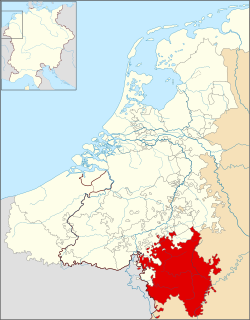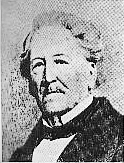See also
| | This Luxembourg-related article is a stub. You can help Wikipedia by expanding it. |
| | This article about a Roman Catholic archbishop is a stub. You can help Wikipedia by expanding it. |
The archbishop of Luxembourg is the ordinary of the Roman Catholic archbishopric of Luxembourg. The position was created on 23 April 1988, when Luxembourg was promoted from a bishopric. The seat of the see is Notre-Dame Cathedral, in Luxembourg City.
| Name | Start date | End date |
|---|---|---|
| Nicolas Adames | 26 June 1870 | 27 September 1883 |
| Jean Joseph Koppes | 4 November 1883 | 29 November 1918 |
| Pierre Nommesch | 8 March 1920 | 9 September 1935 |
| Joseph Laurent Philippe | 9 September 1935 | 21 October 1956 |
| Léon Lommel | 21 October 1956 | 13 February 1971 |
| Jean Hengen | 13 February 1971 | 23 April 1988 |
| Name | Start date | End date |
|---|---|---|
| Jean Hengen | 23 April 1988 | 21 December 1990 |
| Fernand Franck | 21 December 1990 | 12 July 2011 |
| Jean-Claude Hollerich | 12 July 2011 | Present day |

Luxembourg, officially the Grand Duchy of Luxembourg, is a small landlocked country in Western Europe. It borders Belgium to the west and north, Germany to the east, and France to the south. Its capital and most populous city, Luxembourg, is one of the four institutional seats of the European Union and the seat of several EU institutions, notably the Court of Justice of the European Union, the highest judicial authority. Luxembourg's culture, people, and languages are highly intertwined with its French and German neighbors; while Luxembourgish is legally the only national language of the Luxembourgish people, French and German are also used in administrative and judicial matters and all three are considered administrative languages of the country.

The history of Luxembourg consists of the history of the country of Luxembourg and its geographical area.

Western Europe is the western region of Europe. The region's countries and territories vary depending on context.
The Grand Ducal Family of Luxembourg constitutes the House of Luxembourg-Nassau, headed by the sovereign Grand Duke, and in which the throne of the grand duchy is hereditary. It consists of heirs and descendants of the House of Nassau-Weilburg, whose sovereign territories passed cognatically from the House of Nassau to a cadet branch of the House of Bourbon-Parma, itself a branch of the Spanish Royal House which is agnatically a cadet branch of the House of Capet that originated in France. This is descended from the Capetian dynasty – itself a derivative dynasty from the Robertians.

The Southern Netherlands, also called the Catholic Netherlands, were the parts of the Low Countries belonging to the Holy Roman Empire which were at first largely controlled by Habsburg Spain and later by the Austrian Habsburgs until occupied and annexed by Revolutionary France (1794–1815).

William IV reigned as the Grand Duke of Luxembourg from 17 November 1905 until his death. He succeeded his father, Adolphe.

Echternach is a commune with town status in the canton of Echternach, which is part of the district of Grevenmacher, in eastern Luxembourg. Echternach lies near the border with Germany, and is the oldest town in Luxembourg.

Grevenmacher is a commune with town status in eastern Luxembourg, near the border with Germany. It gives its name to and is the capital of the canton of Grevenmacher, and, until its abolition in 2015, the district of Grevenmacher. The town is situated on the left bank of the river Moselle, in a wine growing region.

Dalheim is a commune and town in south-eastern Luxembourg. It is part of the canton of Remich, which is part of the district of Grevenmacher.

The House of Nassau-Weilburg, a branch of the House of Nassau, ruled a division of the County of Nassau, which was a state in what is now Germany, then part of the Holy Roman Empire, from 1344 to 1806.

Notre-Dame Cathedral is the Roman Catholic Cathedral of Luxembourg City, in southern Luxembourg. It was originally a Jesuit church, and its cornerstone was laid in 1613. It is the only cathedral in Luxembourg.

Limpertsberg is a quarter in north-western Luxembourg City, in the centre of Luxembourg.

The Duchy of Luxemburg was a state of the Holy Roman Empire, the ancestral homeland of the noble House of Luxembourg. The House of Luxembourg, now Duke of Limburg, became one of the most important political forces in the 14th century, competing against the House of Habsburg for supremacy in Central Europe. They would be the heirs to the Přemyslid dynasty in the Kingdom of Bohemia, succeeding the Kingdom of Hungary and contributing four Holy Roman Emperors until their own line of male heirs came to an end and the House of Habsburg got the pieces that the two Houses had originally agreed upon in the Treaty of Brünn in 1364.

The County of Luxemburg was a State of the Holy Roman Empire. It arose from medieval Lucilinburhuc Castle in the present-day City of Luxembourg, purchased by Siegfried, Count of the Ardennes in 963. His descendants of the Ardennes–Luxembourg dynasty began to call themselves Counts of Luxembourg from the 11th century onwards. The House of Luxembourg, a cadet branch of the Dukes of Limburg, became one of the most important political forces of the 14th century, contending with the House of Habsburg for supremacy in Central Europe.

Henry VI was Count of Luxembourg and Arlon from the death of his father, Henry V the Blond, in 1281 until his own death at the battle of Worringen, seven years later, when he was succeeded by his son, Henry VII.

Saint Michael's Church is a Roman Catholic church in Luxembourg City, in southern Luxembourg. It is located in Fishmarket, in the central Ville Haute quarter.

The Diocese of Namur is a Latin Church ecclesiastical territory or diocese of the Catholic Church in Belgium. It is a suffragan of the Archdiocese of Mechelen-Brussels. The diocese is a suffragan in the ecclesiastical province in the metropolitan Archdiocese of Mechelen-Brussels. Its cathedra is found within St Aubin's Cathedral in the episcopal see of Namur.
Louis of Luxembourg;. Bishop of Therouanne 1415–1436, Archbishop of Rouen, 1436, Bishop of Ely 1437, Cardinal.

Habsburg Netherlands was the Renaissance period fiefs in the Low Countries held by the Holy Roman Empire's House of Habsburg. The rule began in 1482, when the last Valois-Burgundy ruler of the Netherlands, Mary, wife of Maximilian I of Austria, died. Their grandson, Emperor Charles V, was born in the Habsburg Netherlands and made Brussels one of his capitals.

Orangism was a movement in the 19th century Grand Duchy of Luxembourg favouring the personal union of the Netherlands and Luxembourg under the House of Orange-Nassau. Made up of many notable figures, mainly nobles and Roman Catholic clergy, they were moderate liberals or conservative-liberals and slightly anti-clerical. At first they favoured maintaining the Grand Duchy's autonomous status and, especially during the Belgian Revolution, opposed it being merged into Belgium. In the end the western part of the Grand Duchy passed to Belgium, whilst the eastern part and the Orange grand duchy continued as an independent state. In 1890 the heads of the House of Orange were grand dukes of Luxembourg, but on the death of king and grand duke William III in 1890 he was succeeded by his relation Adolphe as grand duke since Luxembourg's constitution did not allow a woman to hold the throne. The movement's newsletter was the Journal de la Ville et du Pays Luxembourg.